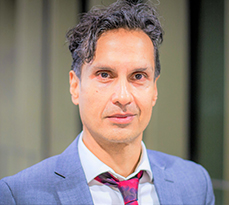Paper co-authored by Professor Shahzad Ansari of Cambridge Judge, honoured by the Strategic Management Society at its annual conference, looks at how established firms can “draft off” a newer dominant technology to create a complementary product.

A paper co-authored by Professor Shahzad Ansari of Cambridge Judge Business School on how established firms can create a new platform by “drafting off” newer dominant technology was named best paper runner-up by the Strategy Process Interest Group of the Strategic Management Society (SMS).
The award, announced at the 38th annual SMS annual conference in Paris last month (September), looks at how tech firm Cisco created fog computing in response to the successful rise of cloud computing.
Cisco did not duplicate cloud but rather drafted off aspects of cloud computing to complement the newer technology – in order to address the need for mission-critical processing power “closer” to devices, thus allowing instantaneous data processing. For example, driverless cars generate 35 gigabytes per hour, which is 30 times greater than high definition video streams. The need for fog was also triggered by the Internet of Things (IoT) and an explosion of connected devices that are expected to soon reach 20 billion.
The study defines such a “drafting off” strategy as “tackling unmet user needs by creating a complementor to the dominant platform” – which enables the new platform to “build upon the technical development and cognitive acceptance of the dominant platform to create and capture value.”
The paper, which looks at Cisco activities between 2008 and 2018, aims to “redirect attention from competitive and winner-takes-all contexts to a neglected but important type of platform strategies: complementing incumbent platforms” and being a connector instead of a disruptor.
Cisco, which provides technology infrastructure including routers and other hardware, faced increasing competition from cloud computing led by firms such as Amazon Web Services that allows companies to store data remotely at a lower cost. So Cisco launched fog computing as a complementary technology to cloud that is more aligned with Cisco’s own technology architecture, and that specifically addressed certain unresolved issues of cloud computing such as security, privacy, data overload and capacity.
“Cisco actively promoted fog as an extension and complementor rather than as being identical or a rival to cloud” as suggested by some media and analysts, the study found. An analogy to describe cloud versus fog computing is the Internet (public cloud) versus an organisation’s Intranet (private cloud).
After being central to fog’s launch and taking a central role, Cisco stepped back: the company joined forces in 2015 with other major firms and organisations such as the Wireless IoT Forum, and then linked up with companies such as ARM, Dell, Intel and Microsoft to develop the Openfog Consortium – which took the lead in promoting this complementary technology. Cisco in 2017 abandoned the “fog computing” trademark to mitigate concerns by partners that it was trying to become the dominant player.
This co-operative tactic was “clearly aimed at connecting cloud and fog,” says the study, which terms this strategy a “seeding and scaling” approach in which Cisco dealt with issues such as “novelty versus familiarity and control versus openness in order to persuade others to collaborate.”
“In this case, cloud computing had in a short period of time become the dominant technology for remote storage,” says Professor Ansari. “Rather than seeking to duplicate cloud, Cisco instead sought to provide added value in specific sectors by complementing cloud’s capabilities while addressing specific needs. For example, in autonomous driving, some computing decisions need to made closer to the car and not in the distant public cloud that would take more time to process data back and forth – as even a difference of milliseconds is critical. Also, amid increasing concerns for data privacy and security, cloud data stored in foreign servers are subject to foreign courts, laws and jurisdictions – and some countries and companies prefer to keep it within national boundaries or inside company walls.
“At this stage, cloud remains by far the dominant technology, but fog has – after being criticised by some analysts as not distinctive enough – now established itself as a serious player in this sector that addresses certain needs in a way that really is different from the cloud approach,” says Shahzad.
The study – entitled “Navigating the fog of strategy: creating a new platform ecosystem by drafting off another” – is based on interviews, archival information and observation, including direct access to the Openfog Consoritium and participation in its internal meetings. The study is co-authored by Dr Saeed Khanagha of Radboud University in the Netherlands, Professor Shahzad Ansari of Cambridge Judge Business School, and Professor Sotirios Paroutis and Luciano Oviedo, both of Warwick Business School.


